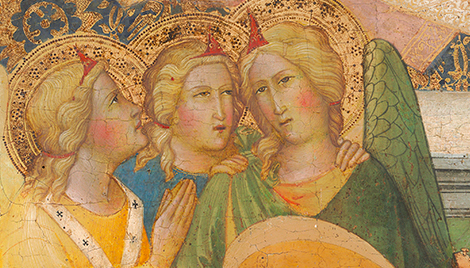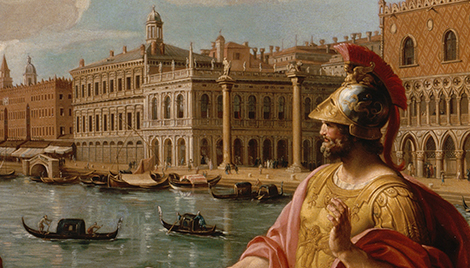Seven Liberal Arts
Seven Liberal Arts
- Artist
- Pesellino and Workshop
- Artist Dates
- c. 1422-1457
- Artist Nationality
- Italian
- Title
- Seven Liberal Arts
- Date
- about 1450
- Medium
- tempera on panel
- Dimensions
- 41.5 x 147.2 cm (16-3/8 x 58 in)
- K Number
- K540
- Repository
- Birmingham Museum of Art
- Accession Number
- 1961.101
- Notes
-
One of two panels created by Pesellino and his workshop: K540 and K541.
Provenance
Giuseppe Toscanelli [1828-1891], Pisa; (his sale, Sambon, Florence, 9-23 April 1883, no. 61). Ludwig Wittgenstein, Vienna, by 1898 through at least 1928. [1] (Count Alessandro Contini Bonacossi [1878-1955], Rome-Florence); sold to Samuel H. Kress [1863-1955] on 16 September 1938 as Domenico di Michelino; gift to the National Gallery of Art in 1939; deaccessioned in 1952 and returned to the Samuel H. Kress Foundation; gift to Birmingham Museum of Art in 1961, no. 61.101. [1] Mentioned in Weisbach, "Exposition de l'art de la Renaissance de collections privées à Berlin," Gazette des Beaux-Arts XX, 1898, p. 158 and again in Raimond van Marle, The Development of the Italian Schools of Painting, vol. X, 1928, p. 504 n. I.
Catalogue Entry
Pesellino and Workshop
Seven Liberal Arts
K540
Birmingham, Ala., Birmingham Museum of Art (61.101 and 61.102), since 1952 and 1960, respectively.(1) Wood. K540, 17 3/8 X 58 15/16 in. (44.1 X 149.7 cm.); K541, 17 1/4 X 58 5/8 in. (43.8 X 148.9 cm.). Slight remains of original inscriptions on the lower step in each panel; inscriptions at the tops of the panels, identifying the Arts and Virtues, are more recent additions. Fair condition except very much abraded and heavily restored. These two panels have been attributed to Pesellino himself, entirely or in part to his studio, and to a specific artist related to Pesellino, such as Domenico di Michelino.(2) Reasonably close parallels for some of the figures may be found in Pesellino's oeuvre: in his panel of Triumphs, for example, in the Isabella Gardner Museum, Boston, and in the former Holford Madonna and Saints now in the Metropolitan Museum, New York. K540 and K541 may well have been painted in Pesellino's studio about 1460, the master himself having a considerable share in the execution of K541. The scheme of the compositions – the Arts and Virtues personified in female figures, each accompanied by a famous exponent of the art or virtue designated by her attributes – follows a tradition reaching back to the early Middle Ages.(3) An outstanding fourteenth-century example is to be seen in Andrea da Firenze's fresco in the Spanish Chapel, Santa Maria Novella, Florence; probably about contemporary with K540 and K541 are two similar panels, attributed to the school of Pollaiuolo, formerly in the Spiridon Collection, Paris.(4) At the right in K540 is the Trivium: Logic, with Aristotle below her; Rhetoric, with Cicero; and Grammar, with Priscian. At the left is the Quadrivium: Arithmetic, with Pythagoras; Geometry, with Euclid; Music, with Tubalcain; and Astrology (Astronomy), with Ptolemy. In the center of K541 are the theological virtues: Faith, with St. Peter; Charity, with St.John the Evangelist; and Hope, with St. James Major. At the sides are the four cardinal virtues: Prudence, with Solon; Justice, with Solomon; Fortitude, with Samson; and Temperance, with Scipio Africanus.(5) Provenance: Giuseppe Toscanelli, Pisa (middle of nineteenth century; sold, Sambon's, Florence, Apr. 9-23, 1883, no. 61, as Castagno). Ludwig Wittgenstein, Vienna. Contini Bonacossi, Florence. Kress acquisition, 1938 – exhibited: National Gallery of Art, Washington, D.C. (424, 425), 1941-46;(6) William Rockhill Nelson Gallery of Art, Kansas City, Mo. (K541 only), 1952-60.(7)
References
(1) K540: catalogue by W. E. Suida, 1952, p. 29, and 1959, pp. 36 f., as Pesellino and Domenico di Michelino. K541: see Kansas City catalogue, note 7, below. (2) J. Schlosser (in Jahrbuch der Kunsthistorischen Sammlungen, vo1. XVII, 1896, p. 34) called K540 and K541 Florentine, early sixteenth century; W. Weisbach (in Gazette des Beaux-Arts, vo1. xx, 1898, p. 158; Francesco Pesellino, n.d. [1901 ?], pp. 90 ff., where he also traces the iconography through earlier centuries) attributes them to Pesellino; S. Reinach (Repertoire de peinttlres, vo1. III, 1910, p. 751) gives them to Castagno; A. Venturi (Storia dell'arte italiana, vol. VII, pt. I, 1911, p. 396) rejects the attribution to Pesellino and later (in ms. opinion) gives them to Domenico di Michelino; P. Schubring (Cassoni, 1923, pp. 281 f) says they are in the manner of Pesellino; R. van Marle (Italian Schools of Painting, vo1. x, 1928, p. 504 n. 1) thinks them Florentine, a generation later than Pesellino. In ms. opinions G. Fiocco gives them to Domenico di Michelino; R. Longhi, to Domenico di Michelino, based on Pesellino; F. M. Perkins, to Pesellino bottega. B. Berenson (Italian Pictures ... Florentine School, vol. 1, 1963, p. 167) lists them as from the studio of Pesellino. (3) Weisbach, Francesco Pesellino, loc. cit. in note 2, above. (4) Reproduced by Schubring, pl. LXXXI of op. cit. in note 2, above; and by R. van Marle (Iconographie de l' art profane, 1932, fig. 47), who makes an extensive study of medieval and Renaissance personifications of the Virtues. (5) The unusual type of halo in K541 appears again in a fifteenth-century Florentine personification of music in a private collection (reproduced as fig. 50 of the catalogue by St. John Gore of the exhibition 'The Art of Painting in Florence and Siena from 1250 to 1500,' Wildenstein's, New York, Feb. 24-Apr. 10, 1965). (6) Preliminary Catalogue, 1941, pp. 56 f, as Domenico di Michelino. (7) Catalogue by W. E. Suida, 1952, p. 30, as Pesellino.










